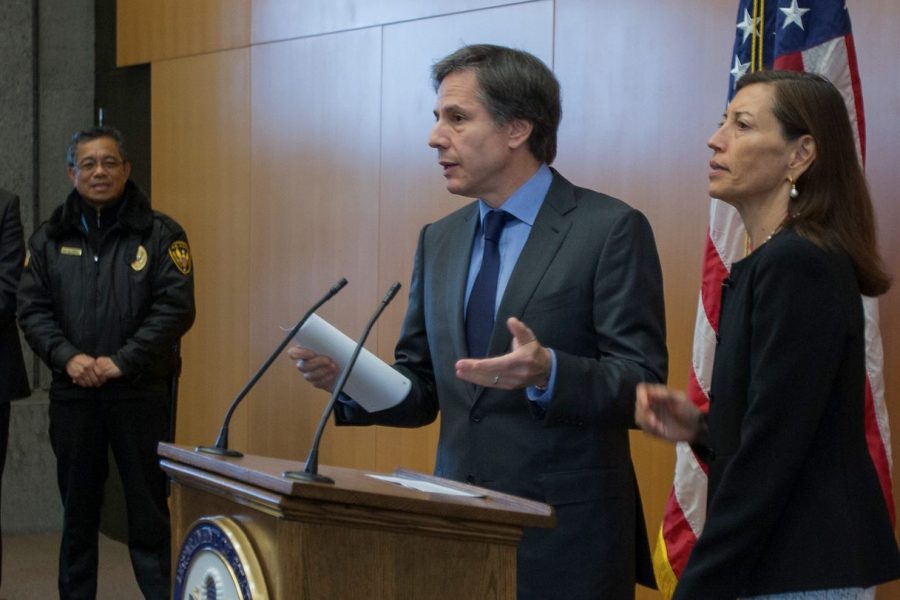Opinion | US needs a diplomatic spark in Ukraine
Photo courtesy of United States Mission Geneva/Flickr
Ambassador Pamela Hamamoto introduces U.S. Deputy Secretary of State Antony Blinken with the U.S. Mission Geneva team Mar. 3, 2016. Senior columnist Eddie Ryan argues that the U.S. needs to take diplomatic action in the Ukraine and Russia dispute.
Feb 9, 2022
The situation in Ukraine is growing tenser by the day, and the tension has a unique source. Over the past two weeks, many things have changed — revelations have emerged, NATO countries have taken action. And yet, nothing major has happened. It’s an ominous blend of shifts and stasis for what could become Europe’s largest ground war since World War II.
Let’s hope that possibility isn’t realized. Unfortunately, from recent developments, it’s difficult to tell what might happen. The United States is running out of time to do what it must: convince Russia that Ukraine won’t join NATO anytime soon.
Two weeks ago, the United Kingdom uncovered a Russian scheme to install a pro-Moscow leader in Ukraine. It’s unclear whether the planned coup hinged on a Russian invasion, or if the Kremlin hoped that its maneuvers alone would inspire enough disorder to topple Ukrainian President Volodymyr Zelensky.
Either way, the fact that this story quickly fell from the headlines illustrates just how fast the crisis is progressing.
Then came Germany’s divergent behavior. President Biden has trumpeted NATO’s unity in this dispute, and it’s probably more than Putin expected. Still, Germany’s reluctance to oppose Russia is a weakness too glaring for NATO to conceal.
Get The Daily Illini in your inbox!
First, Germany blocked Estonia’s bid to transfer German-manufactured weapons to Ukraine — weapons Estonia already possessed. Britain was also prevented from using German airspace to send Ukraine weapons. These moves could be due to Germany’s desire to secure the Nord Stream 2 pipeline, which would bring large quantities of natural gas from Russia.
While disconcerting, Germany’s conduct shouldn’t dictate the outcome. Yes, it’s quite lame watching Olaf Scholz, the new social democratic chancellor, bow to the private sector and an autocrat. Still, even with Germany on board, it’s not clear that NATO’s strategy would assuage Putin anyway.
In fact, diplomacy has yielded very little progress. The U.S. wrote Russia a response to its demands of a month ago; though not made public, it reportedly rejected the Ukraine-NATO ban but offered other paths of negotiation. Some dialogue is better than none, even if it offers nothing substantively new. These talks are hurtling toward a dead end.
To understand the fuss over N.A.T.O. expansion, Joshua Yaffa reminds us, one needs a bit of history. Putin’s version of history, that is. The Russian leader sees himself as the author of the post-Soviet order, heir to Gorbachev and Yeltsin’s diplomatic mistakes — namely, those in 1990 and 1997.
In 1990, U.S. Secretary of State James Baker suggested a hypothetical scenario to Gorbachev in which NATO would house a reunified Germany and “not shift one inch eastward.” Later, Baker rather flippantly said that deals with the USSR didn’t count since the bloc no longer existed. What’s more, those weren’t the terms of the reunification deal anyway. Regardless, Putin views NATO’s expansion as a betrayal.
Seven years later, after a blundered statement on the prospect of Poland joining NATO, Yeltsin claimed that the 1990 agreement forbade NATO troops from being stationed in Warsaw Pact territories east of East Germany. The agreement really stipulated that foreign troops couldn’t set foot in East Germany; it didn’t concern any other countries.
Hence, Putin’s demand that NATO retreat from Eastern Europe to its pre-1997 stations. Whether he believes his own claims or not, Putin wants his sphere of influence. With NATO members sending troops, weapons and vehicles to Poland, the Balkans and the Baltics, he won’t get it easily. But this view of history underlies Putin’s approach and can’t be overlooked.
To make matters worse, the U.S. recently managed to piss off Russia and Ukraine in one go by recalling the families of its diplomats in Kyiv. On the one hand, it’s weird that Ukraine would accuse the U.S. of alarmism given the stakes. On the other, as Fred Kaplan writes, Ukrainians might fear America expects war and will compromise with Russia too soon — at Ukraine’s expense — to avoid it.
Add to this the Irish fishermen from County Cork who thwarted Russia’s plan to stage war games off Ireland’s west coast, and it’s clear that we could be witnessing a world-historical event.
It’s important to remember NATO expansionism, perhaps both unnecessary and unwise, contributed to this mess. Putin is the dangerous instigator, but NATO has long had hegemonic tendencies. Convincing Putin that Ukrainian membership won’t happen anytime in the next decade or so thus remains essential.
It’s unclear if this assurance will satisfy Putin. His ambitions may extend beyond Ukraine. Nevertheless, it’s the best diplomatic option for the U.S. and NATO at this stage — and one which hasn’t been tried in earnest.
Eddie is a junior in LAS.






